The server certificate cannot be verified.
See 5.1.3
connect two servers and two security servers.
Load the SAN certificate, worked very well so far.
I believe that server updates of windows groups installed on the servers of connection (although I don't see why that would be a problem) and now the dash is RED and indicates the server certificate could not be verified, to Sérères of connection and two security servers.
CertificateRevocationCheckType is set to 1 on alreay connection servers.
Any idea?
Co-worker deleted the registry key, restarted broker and recreated the registry key that makes green again.
Strange!
Tags: VMware
Similar Questions
-
BBM v7.0.1.23
BlackBerry 8530
V5.0.0.459 smartphone (Platform 4.2.0.201)
recently upgraded to BBM V7.0.1.23 and now receive message repeated 'you try to open a secure connection, but the server certificate chain is not valid.
battery pulled, continues to occur.
I would appreciate your help to resolve.
This was bugs me for a few weeks now, after update BBM to try BBM voice
see article ID KB33968 knowledge base
. . . I tried to insert a link shortcut to the URL, but it was not allowed.
Looks like a fudge like BB issue a correction. I have not tried myself but is told by the way, but I'll do it later today.
-
Hello
I just upgraded to macOS Sierra and built-in Cisco IPsec VPN no longer works. When you try to connect, I get a "cannot validate the certificate of the server. "Check your settings and try to reconnect" error message. I use Cisco ASA with self-signed certificates and everything worked fine with previous versions of OS X.
Please help me, I need my VPN Thx a lot
I am having the same problem with StrongSwan and help cert signed with the channel to complete certificates included in the pkcs12 file imported to the keychain. It was working properly in El Capitan, but now broken in the Sierra.
-
Security certificate cannot be verified.
When I open outlook opens an Internet security warning window that says: "the server that you are connected using a security certificate that could not be verified. The CN of the certificate name does not match the passed value. Using the server? "I used the same laptop and the Internet even for years. This has also caused problems when I took my laptop to another location & tried to put in their key. The IP address has been blocked. What can I do about my security certificate?
You just need to update your root certificates.
To do this, consult the following article:
"Members of the certificate program root Windows.
<>http://support.Microsoft.com/kb/931125 >Skip down to the section:
"Root Update Package (planned for Windows XP only)"
Download the file and run it.HTH,
JW -
Download the file to the server / others cannot see
Hello!
When I publish my captivate (for a network space) project and upload them to the server, I am able to view the file .html very well. However, if we try to see on another computer, what we see is a screen empty. Who has access to the folder network also cannot see. It is only visible on my computer! Any ideas?
For the record, I work with Captivate 5 on a Windows 7 computer. We all use the same operating system and the browser.
I tried this fix: http://blogs.adobe.com/captivate/2010/08/unable-to-open-exe-files-published-from-adobe-cap works - 5.html, but it did not work. (In fact, now I see a white screen when I try to visualize the project online!)
I appreciate any help!
Thank you.
Thank you, Sara.
You have an animation of text in your project? If so, can you please remove the text animation and re - publish your project and check if it is accessible from the network location. If it works, follow these steps:
1. install the patch CP5 from here: http://kb2.adobe.com/cps/881/cpsid_88142.html
2 restart the Captivate, open your project, including text animation
3 to republish your project and check if it works from the network location.
Please let me know the results.
Thank you
Sushma
-
Update module intercepted error: 12007 the server name cannot be resolved
AHI get dialogue when the computer starts windows 7 Professional update failure. The update module intercepts an error: the error code is 12007. The server name could not be resolved. Check that your internet connection is active and that no system of filtering or security is blocking the connection (Control Panel > Internet Options)
I run a network home and the internet is connected but still this problem, I use Outlook 2003 Pro and have noticed desktop updtae KB907417 and ms outlook 2003 junk mail filter KB2466074 not sure if this the problem that all other windows update install, it may not update some aspects there are 3 files that will not update service of office 2003 pack 3 (sp3).
Thank you 1 million in advance - too small Word uses IE8 32 bit as default browser
Did cancel registration and re-register it, this seems to have solved the problem thanks for all your help
-
Console remote vCenter - the server name cannot be resolved
When I run the utility of Vcenter web-based console, a new web page opens and displays the console but I get the following error:
"The server name could not be resolved."
Here is a screenshot:
Here is the URL of the remote console tries to display:
I am a student from progressing to a VTC VCP5 Certification community college. We use the VMware Network Netlab Academy facility. I have no access to the client based on Windows Vcenter. I have only the client on the Vcenter web access.
Many many thanks Andre! The work of Console launch. After that I removed the entries in/etc/hosts localhost to the server vcenter-1, I brought successfully to the top of the console window. Of course, I also had to add an entry for the host esxi-1 in each file/etc/hosts.
The console works great. I was able to connect and send commands of Linux; However...
The only remaining question I have is that the console returns to Mode "full screen" by default and I can't seem to exit full screen mode. It encloses the vclient overall utility. Is it possible to tell the coming launch mode console non-plein default screen? Y at - it a remote console setting that controls "Full Screen Mode".
Scott...
-
I rebooted the phone. Still no luck.
I downloaded the HP eprint app and that the app has not found the printer automatically, so I had to enter in the INVESTIGATION period.
I wonder what happed initially, maybe hackers, I don't know.
Anyway, thanks a lot for your help!
-
How to get rid of the warning "Publisher cannot be verified?
Hello
is there a way to get rid of this warning for a specific .exe file? by clicking the checkbox 'don't ask me' does not help.
Thank you
KonstantinI found a way to get rid of the warning by removing the alternative streams of the executable. See http://technet.microsoft.com/en-us/sysinternals/bb897440.aspx
Konstantin
-
VMware Update Manager Install Failed: VCenter Server credentials cannot be verified
When you try to install VMware Update Manager 5.1 on Windows 2008 R2, but fails:
VMware Update Manager-build-1022478: 05/12/13 15:30:57 - start logging.
VMware Update Manager-build-1022478: 05/12/13 15:30:57 - CA exec: VMValidateVCServerInfo
VMware Update Manager-build-1022478: 05/12/13 15:30:57 getting property VC_SERVER_IP = 192.168.75.1
VMware Update Manager-build-1022478: 05/12/13 15:30:57 getting property VC_SERVER_PORT = 80
VMware Update Manager-build-1022478: 05/12/13 15:30:57 Getting property VC_SERVER_ADMIN_USER = administrator
VMware Update Manager-build-1022478: 05/12/13 15:30:57 getting property TEMP_DIR = C:\Users\ADMINI~1\AppData\Local\Temp\1\
VMware Update Manager-build-1022478: 05/12/13 15:30:57 AppendPath::done path: C:\Users\ADMINI~1\AppData\Local\Temp\1\vum
VMware Update Manager-build-1022478: 05/12/13 15:30:57 command validation VC: ["v 192.168.75.1 Pei 80 - U 'administrator' Pei * C-"C:\Users\ADMINI~1\AppData\Local\Temp\1\vum\' L-'C:\Users\ADMINI~1\AppData\Local\Temp\1\\' vcversion - O""]
VMware Update Manager-build-1022478: 05/12/13 15:30:57 AppendPath::done path: C:\Users\ADMINI~1\AppData\Local\Temp\1\vum\vciInstallUtils.exe
VMware Update Manager-build-1022478: 05/12/13 15:30:57 found 'C:\Users\ADMINI~1\AppData\Local\Temp\1\vum\vciInstallUtils.exe '.
VMware Update Manager-build-1022478: 05/12/13 15:34:18 process returned 199
VMware Update Manager-build-1022478: 05/12/13 15:34:18 error: unknown error VC
VMware Update Manager-build-1022478: 05/12/13 15:34:18 get the property UILevel = 5
VMware Update Manager-build-1022478: 05/12/13 15:34:18 get property ProductName = vSphere VMware Update Manager
Well your files rui.crt and rui.key have become 0 size is why this problem occurs. Stop the autodeploy service and try the installation again.
Concerning
Girish
-
How to fix VMware View Server certificate revocation check connection error?
Dear community,
For about 2 weeks, I feel a revocation of the certificate check error in our environment Horizon see 6.2. The strange thing is that, within 12 hours about two (replication) connection servers and the vCenter Server / server of composer (on the same machine) are considered as having invalid certificates, even if, in fact, they are valid (CA certificates). We use no security servers.
The view admin console shows the following for servers connection:
The server certificate is not approved.
The server certificate cannot be verified.
For the vCenter, he said (that I have validated manually the certificate):
No problems found.
Certificate is not approved, but the thumbprint of the certificate is accepted.
With the connection series on 'full', States that the login server logs for the vCenter server:
TRACE (B 17-0 - 0E98) < VCHealthUpdate > [NativeKeyVault] validateCertificateChain response: {result = FAIL, EndEntityReasons = cantCheckRevoked, ChainReasons = invalid, SelfSigned = false, EndErrorCode = 16777280, EndInfoCode = 258, ChainErrorCode = 16777280, ChainInfoCode = 256, PolicyErrorCode =-2146885613}
As far as I can see there no similar entries for login server certificates in the newspaper.
At the moment I am under the environment with composer and vCenter certificates manually valid and invalid connection (red) server certificates (as view clients and browsers are not disabled).
I already checked that I am able to do everything 'green' again via setting the registry key 'CertificateRevocationCheckType'2 (as described here Configure the server certificates certificate revocation check). This brings me to the conclusion that one of the intermediate certificates cannot be validated. So, I had the information a "version" of an intermediate (intermediate certification authority) certificate has been revoked. There seems to be no coincidence - like the time point is as well, but this particular version does not appear to be used in the servers of my connection.
However, even with full logging enabled, I can't information which (intermediate) certificate cannot be validated and why. I expected to see something like 'OCSP verification' or 'check the CRL' but I can't find it in the newspapers. However, I noticed that one of the intermediate certificates lacked the OCSP URL (even if the field "Authority Information Access" existed). Of course I updated the certificate with a version that contains the OCSP URL, but it has not changed anything.
In addition, I checked manually all of the certificates in the chain with openssl (for OCSP) and CRLs as well, but everything seems to be OK (all URLS are accessible and no opportunity of certificate has been revoked). Actually, I do not interpret the error as "that the connection to the server is an invalid certificate because it has been revoked", but "it cannot check if it has been revoked. The servers do not need a proxy and nothing configured, so (I checked the proxy settings system context, also).
For now, the problem is not critical, such as 'red' status connection server has no effect on our customers and so I could turn off certificate revocation check (or switch to check that the certificate of the server (2)). But of course, I would really solve the problem.
Is there someone who can give me a hint on what to check, for example, how do I know which certificate cannot be controlled and why? Someone had the same or a similar problem? Support VMware is working on the problem as well, but they seem don't know is not the problem, either.
I appreciate the thoughts and responses! Thank you!
Best regards
Fabian
Dear community,
During this time, I was able to correct the error described at the beginning of this thread. Jump to the end to see what could probably help you...
- At first, I installed an additional standalone VMware View Server connection in order to check the following related certificates:
- VMware support always told me to renew my certificates because they "were not valid" etc. - even if in fact they were (like external URL calls and attested manual verification and tests).
- That's why I created new additional certificates for the login server and configured to include the vCenter even as my production environment - only difference was I didn't inlcude the composer who runs the server vCenter himself.
- The result was that the server was "green" including both the vCenter Server certificate which could be 'not reliable' by the environment of production - strange, huh?
- After I reset the additional server to a turned wink where connection to the server was not yet installed (before that, I uninstalled the connection to the server in case there is information in vCenter thereon) and reinstalled as a replica of the production environment server. Somehow I expected this, but still quite strange the vCenter Server (and composer) now again was considered "invalid", even if the certificate of the server connection itself considered still valid and green. For test purposes, so I put certifice revocation checking on '2' (only one server certificate check) - but only on the 'old' production servers' and 'magical' everything has been considered valid. So as I see it, there seems to be some sort of information stored on the 'old' connection servers that makes them believe that invalid certificates and that the information is replicated on the third server unless I lower the revocation of the certificate controls on these servers. Altervative explanation could be that VMware View does not accept certificates with aliases that do not include the 'real' server name - that is / was in fact certificates the old servers connection. The new server certificate connection included the real name and the alias. I understand if this is the case, but then I expect that it be documented somewhere (I have not found this information) and also wouldn't understand why it worked without problem for several years before.
- After finding that out, I created new certificates for the 'old' connection servers, including aliases and real names and replaced the certificate on one of the servers (and restarted the login server) - only a few successfully. Once I put the revocation checking on '4' again on this server, the login server certificate was still considered valid, but not the vCenter and certificate of composer.
- Now, I've uninstalled the old login server (removed from the view) and reinstalled completely (including an update of the 2008 R2 2012 R2 OS) and after I have it reintegrated into the environment, everything remained green - as long I have will activate revocation checking on the second login server "old." This is why I did the same with this (completely reinstalled and reinstated it) and now everything is green with the revocation checking enabled on all replicas of server connection.
- The next step I uninstall the additional replica because I created only for troubleshooting purposes.
So what will no doubt help in similar cases:
- Reinstall the servers of connection one by one, including:
- Uninstalling html access (if used), uninstall the login server to view, uninstall 'VMware' AD LDS Instance.
- Removal of the connection to the server of replication group: run "s - r s uninstalled_ vdmadmin.exeservername" on one of the servers connection remaining.
- Reinstall/Update OS (may not be necessary, but I did not test that)
- Reininstall, return to the login server replica. If you used the certificates which included only the alias of the server I recommend you to create new ones, including the name of the server as well, but maybe it's not necessary as well. If you want to keep the certificates which only inlcude the alias it will be necessary to install this certificate after the first replication of the servers (see below).
My question for technicians of VMware/developers: It is supported to use certificates include only the server alias. Otherwise why it worked before and where is it documented? Where are certificate cached information so that simply replace the certificate was only some, and not a complete success (see above). FYI - when I paired initially replicas that I had to install the CA (including only the pseudonym) after the first replication - now with certificates (including the server name and the alias), I could install the certificate before you replicate (= the login server installation).
- At first, I installed an additional standalone VMware View Server connection in order to check the following related certificates:
-
Cannot set the IMAP mail - configuration cannot be verified
Hello
I have trouble to set up my work as an Exchange IMAP messaging in a new installation of Thunderbird. Once I put in the address of the server that Thunderbird retrieved all the security settings, which I checked against the supplied parameters that are listed in the webmail. I've also used these parameters to configure mail IMAP on my phone for triple controls everything. However, in the account configuration screen, I still got the message "Configuration cannot be verified - your name of user and password correct? (again, I checked everything I used independently and they have been accepted). Once I came out of the initial configuration screen error replaced by the following:
"The GSSAPI/Kerberos ticket is not accepted by the < email address > IMAP server. Please check that you are connected to the Kerberos/GSSAPI Kingdom".
The only possibility I can think is that Thunderbird tries to use my e-mail instead of the server to authenticate the reason why I'm getting the error. The e-mail address is [email protected] while the server is soliscom.uu.nl.
Any help or suggestions that anyone has would be welcome,
See you soon.Under Tools/account settings /AccountName/Server Settings, check that you have for the authentication method. "Normal password" is not the most common configuration for secure connections, Kerberos/GSSAPI, which seems to be the reason why you get the error message.
But if you are sure that the Kerberos/GSSAPI authentication is required, see this article for instructions on how to make the necessary changes in the Config. Publisher:
https://ITServices.Stanford.edu/service/emailcalendar/email/config/thunderbird_imap_kerb
-
How to install the ssl certificate in windows server 2008?
Hello
Can someone give me the steps to install the SSL certificate on my application hosted on windows server 2008 R2?
Hello
Although technet.microsoft.com should be the best forum for the problems of server below is a guide on how to install an SSL certificate.
It will be useful.
To install your newly acquired in IIS 7 SSL certificate, first copy the file somewhere on the server and then follow these instructions:
- Click on the start menu, go to administrativetools and click on Manager of Services Internet (IIS).
- Click the server name in the links on the left column. Double-click server certificates.
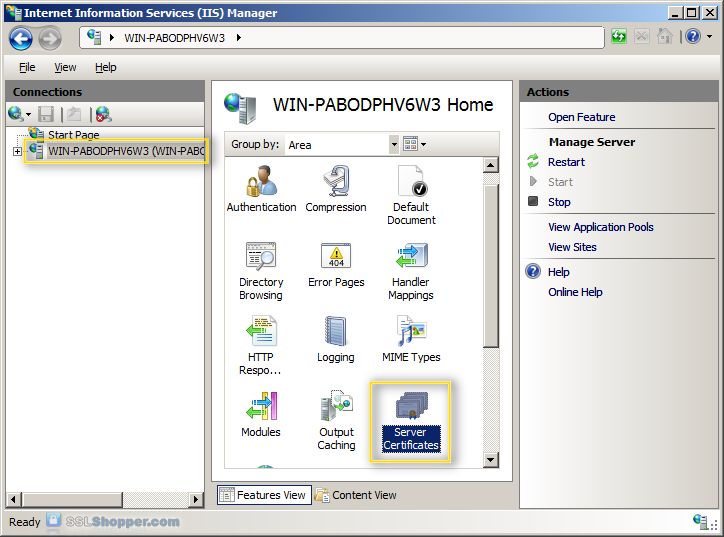
- In the Actions column to the right, click Complète Certificate Request...
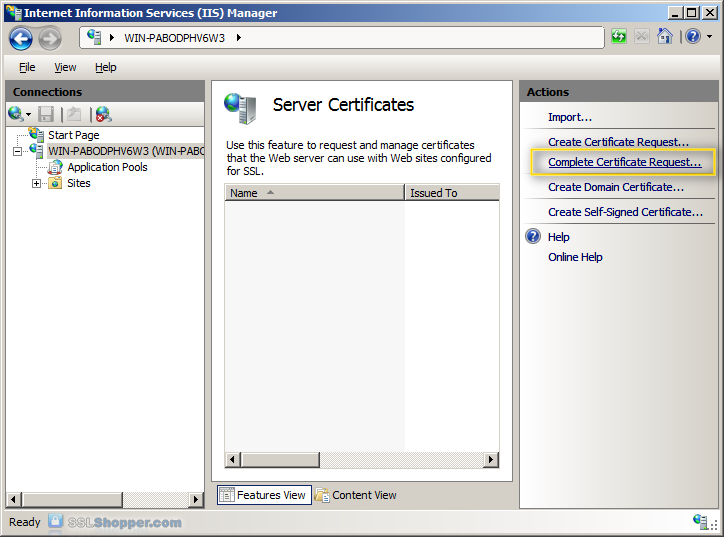
- Click on the button with the three points, and then select the server certificate that you received from the certificate authority. If the certificate does not have a .cer file extension, select this option to display all types. Enter a friendly name that you can keep track of certificate on this server. Click OK.

- If successful, you will see your newly installed in the list certificate. If you receive an error indicating that the request or the private key is not found, make sure that you use the correct certificate and you install it on the same server that you generated the CSR on. If you are sure these two things, you just create a new certificate and reissue or replace the certificate. If you have problems with this, contact your certification authority.
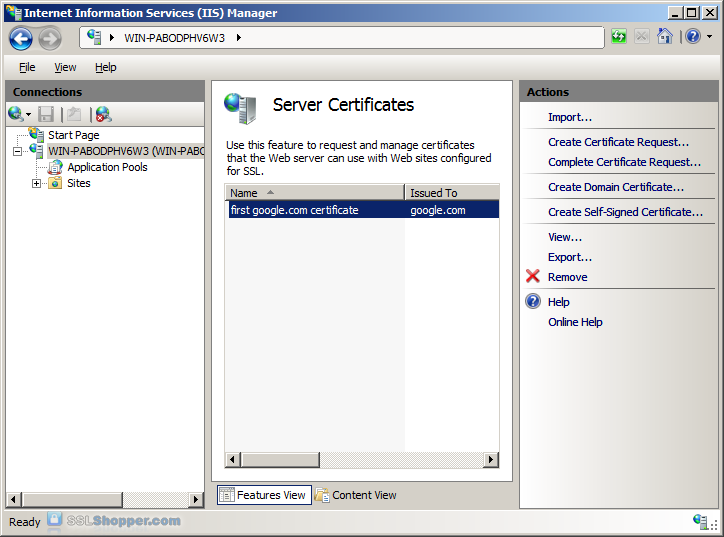
Bind the certificate to a Web site
- In the column of links on the left, expand the sites folder, and click the Web site that you want to bind the certificate to click links... in the right column.

- Click the Add... button.

- Change the Type to https , and then select the SSL certificate that you just installed. Click OK.
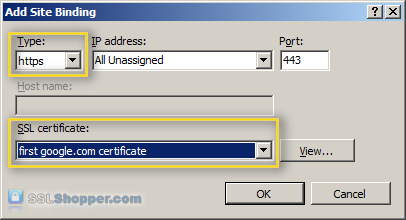
- You will now see the listed link for port 443. Click close.
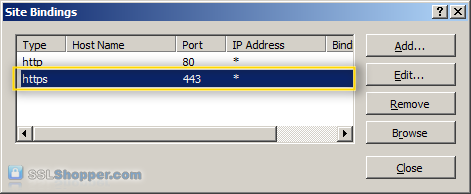
Install all the intermediate certificates
Most of the SSL providers issue certificates of server out of an intermediate certificate so you will need to install the intermediate certificate on the server as well or your visitors will receive a certificate error not approved. You can install each intermediate certificate (sometimes there are more than one) by following these instructions:
- Download the intermediate certificate in a folder on the server.
- Double-click the certificate to open the certificate information.
- At the bottom of the general tab, click the install Certificate button to start the Certificate Import Wizard. Click Next.
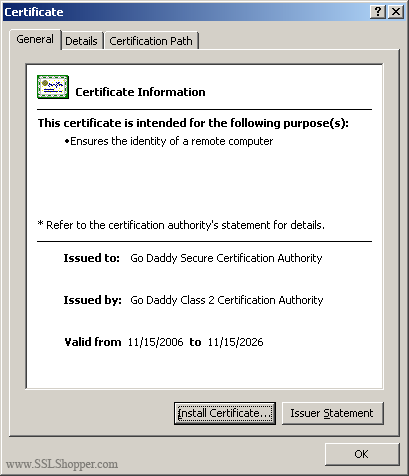
- Select place all certificates in the following store , and then click Browse.
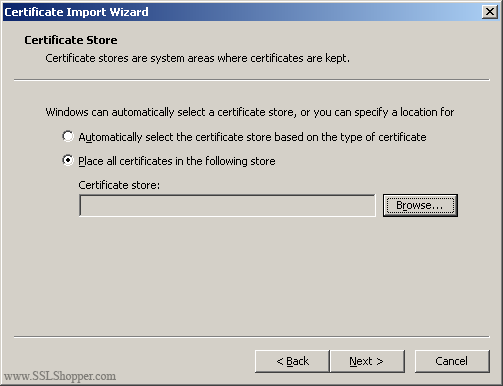
- Select the Show physical stores checkbox, then expand the Intermediate certificate authorities folder, select the below folder on the Local computer . Click OK. Click Next, and then click Finish to complete the installation of the intermediate certificate.
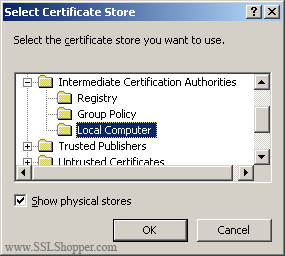
You may need to restart IIS so that it starts the new certificate to give. You can verify that the certificate is installed correctly by visiting the site in your web browser using https rather than http.
Links
- Move or copy an SSL certificate on a Windows Server to another Windows Server
- How to disable SSL 2.0 in IIS 7
- How to configure the SSL in IIS 7.0
- Video tutorials to install an SSL certificate in IIS 7 to NetoMeter
Kind regards
Joel
-
Help generate the SSL certificate for the Security Server
Hi people,
We have server (ss - 01.mydomain.local) security and connection server (cs - 01.mydomain.local). Now intend to install a certificate on the Security server. What should be the common name.
our Web site is something like access.mydomain.local.
Also, we plan to install SSL only on security for internet access server, this will affect the internal users, access to the connection to the server.
Thanks and greetings
J P Raj
Take a look at the link below
Internal users will not be affected when you install the Security server certificates
Simply create a CSr file > get certificates and import them to the Security server in the MMC guide explains practically everything. If you already have certificates wildcard certificates, then you can follow the sub process
(a) export the server certificates
(1) to connect to the server that has certificates
(2) for this server to export it to a PFX format certificate.
(3) open the Microsoft MMC Certificates snap-in for the computer account.
4) navigate to certificates (Local computer) > personal > certificates.
(5) right-click on the signed certificate that is to be exported.
6) click all tasks > export.
(7) on the Welcome screen, click Next.
8) click Yes, export the private key.
(9) if it is an option, click on include all certificates in the certification path.
(10) enter a password for the private key. This is required for the import certificates.
(11) to enter a file name and location. For example, C:\certificates\certificate.pfx.
12) click Next.
13) click Finish.
b) import it to the use of broker or planned connection securityr.
Certificates of thye 1) import (preferable Pfx format) for the server broker or planned connection security.
(2) open the Microsoft MMC Certificates snap-in for the computer account.
3) navigate to certificates (Local computer) > personal > certificates.
(4) right-click the certificates.
5) click on Import.
(6) through the pfx and click Next.
(7) enter the certificate password.
(8) select Mark keys as being exportable.
9) click Next.
10) click Finish.
(c) restart Consulting Services
To restart the services:
Log in as an administrator on the server that is running the Server VMware View connection server VMware View connection or VMware View Server Security.
Click Start > run, type services.msc and press ENTER.
In the list of services, right-click on the VMware View connection Server or VMware View Server Security service.
Click on restart and wait for service to stop and start.
-
Server instance cannot start because the Weblogic domain integrated
Hi all
I use the new version of Jdeveloper. IE 11.1.1.6.0. I get the error "The Server Instance cannot be started because the integrated Weblogic domain has not been built with success." whenever I try to run a page simple jspx.
Please someone help me.Hello
Welcome to OTN.
You can try the following.
1. close JDev.
2 remove the DefaultDomain file under your [url http://tompeez.wordpress.com/tag/system-folder/] file system.
3. launch JDev
4. run your jspx page.Arun-
Maybe you are looking for
-
can't update my firmware ver 1 current tp (ver 5) f3 nex... why?
downloaded the updated firmware for nex f3. the current version is ver 1 and update for ver 5... I can't install the update!
-
Is there anyway that I can keep the properties of the control, as shown in the image attachment if I add another event in the same case of event structure? Currently, I have a case of structure of event set up to run on a mousedown event on a multi c
-
Hello. I have Acer ICONIA A100. I want to install the new application, but I got eror on less disk space. When I connect my Windows Tablet PC, I can to see this: but when I go on the selected disk all the files, I had different information: Where is/
-
I don't have the activation code for my Windows Vista.
OT: activation code. I have a computer dell laptop with windows vista. The OS has been corrupted and I had to reinstall Vista. I lost the original disk, but concluded that a backup I had made when I got the computer. It worked, but I don't have the
-
I have a HP G62 I've had for about 2 years. It started crashing not too long and has gotten to the point where about five minutes after that be turned on he would give me the blue screen with white rental and restart the computer. Now it won't even t



